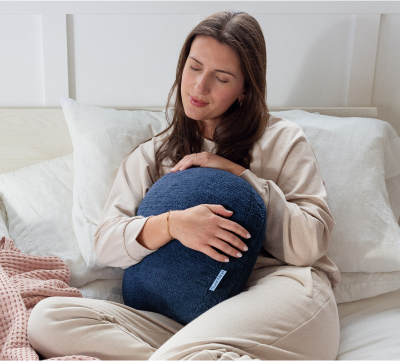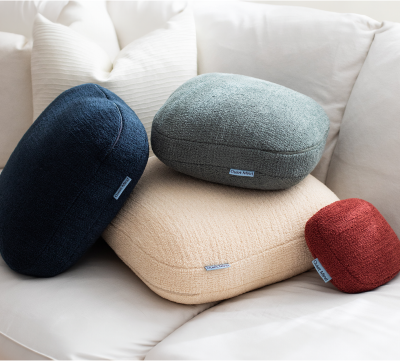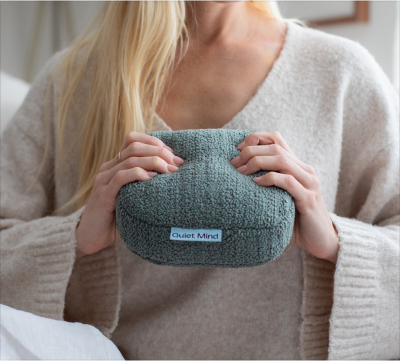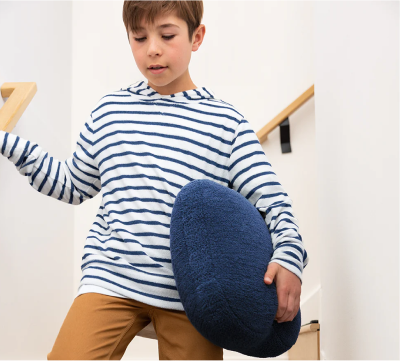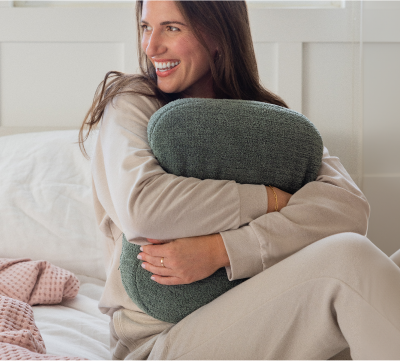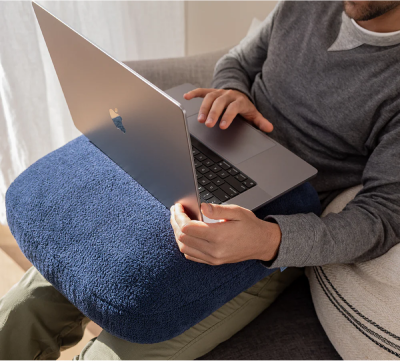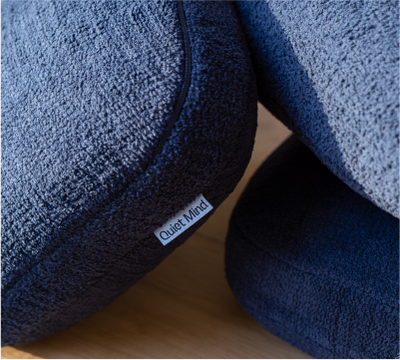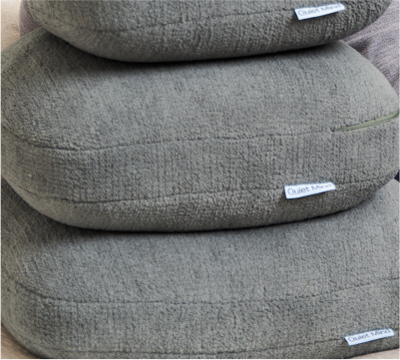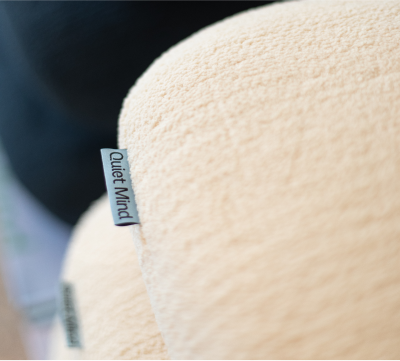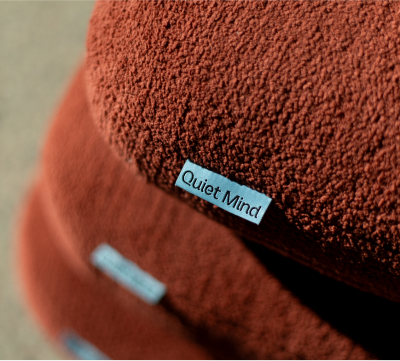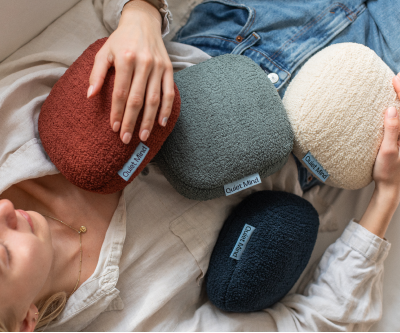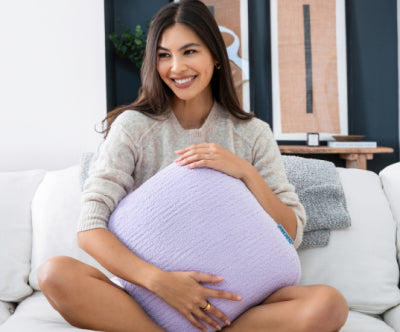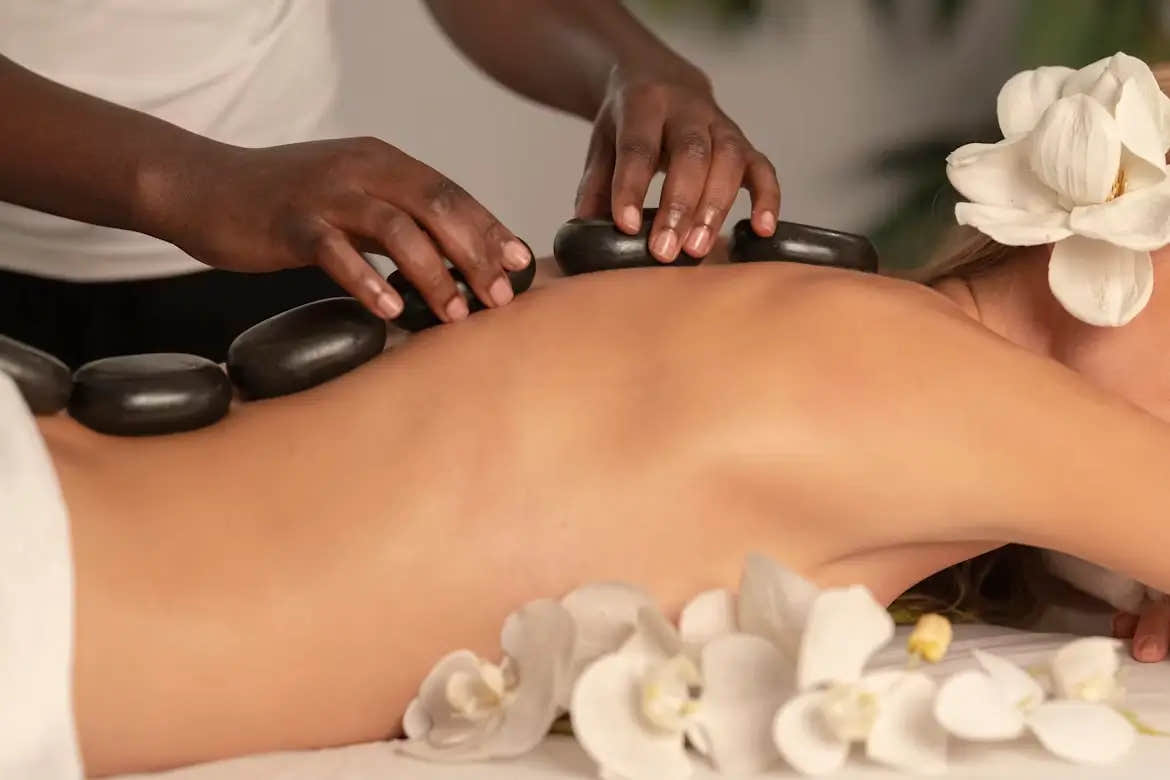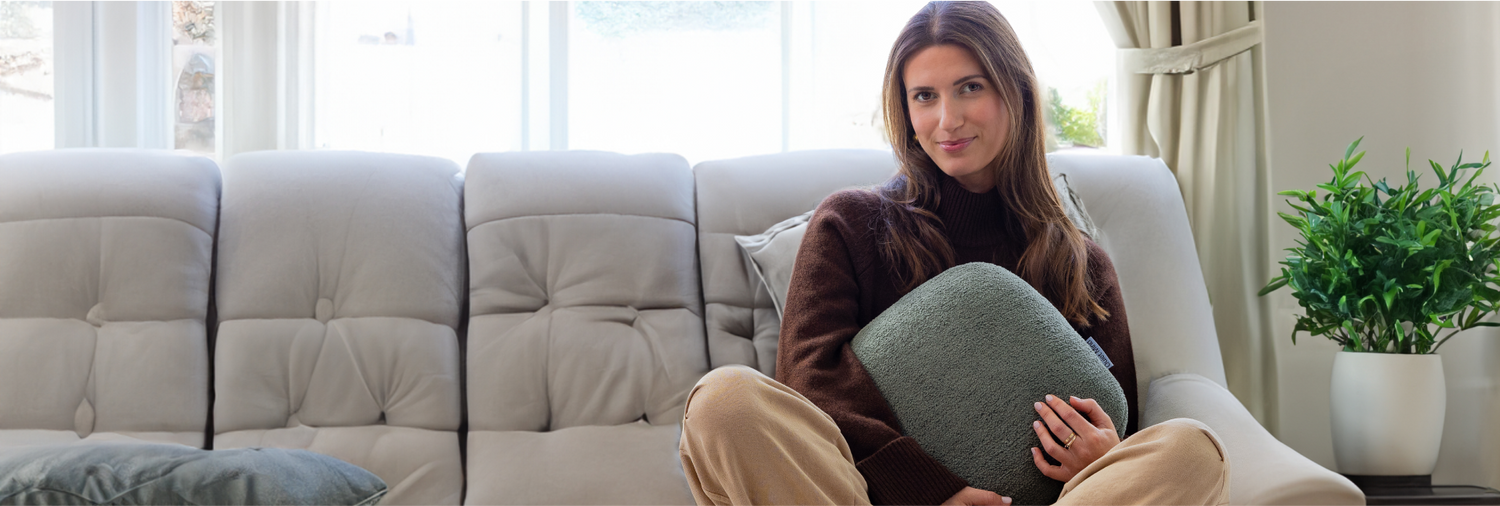Anxiety doesn’t always show up as racing thoughts. Sometimes, it hides in the shoulders, the chest, or the base of the skull; building slowly until your whole body feels tense. In these moments, touch becomes more than comfort. It becomes a pathway back to yourself.
Massage and acupressure are two gentle, accessible tools that may help ease anxiety symptoms by working directly with the nervous system. From light fingertip massage to applying pressure on specific points, these techniques can create space for your body and mind to soften.
Let’s explore how massage and pressure points may help relieve stress and anxiety, and how you can use them at home to feel more grounded and supported.
How Massage Helps with Anxiety and Stress Relief
Massage isn't just about relaxation; it’s a way to reset your nervous system. By stimulating areas of tension and encouraging energy flow, massage supports the body in shifting from a stress state (fight-or-flight) to a regulated one (rest-and-digest). This transition can calm anxiety down naturally, supporting both emotional and physical balance.
This shift may help:
- Lower cortisol and stress hormone levels.
- Improve circulation and oxygen flow.
- Promote the release of endorphins, serotonin, and dopamine.
- Calm the mind and increase a sense of safety.
- Reduce physical symptoms of anxiety, like chest tightness or muscle tension.
Massage also offers a way to reconnect with your body. When you feel anxious or overwhelmed, bringing awareness back to physical sensation; such as through gentle pressure, can interrupt the cycle of anxious thoughts and help you manage stress more effectively.
Regular massage becomes a ritual of care. Not just temporary relief, but a supportive rhythm for long-term emotional well-being.
Morning vs Evening: When to Massage for Anxiety Relief?
There’s no one-size-fits-all answer. The best time to use massage for anxiety relief depends on your lifestyle, energy, and emotional rhythms.
Start with a few minutes of mindful observation: when do symptoms of anxiety tend to arise? Do you feel your anxiety increase at the start of the day, or does stress build over time?
Morning Massage May Help:
- Loosen overnight tension.
- Calm an increased heart rate upon waking.
- Establish a grounded, focused tone for the day.
- Prevent stress from accumulating early on.
Evening Massage May Help:
- Release the mental load of the day.
- Improve sleep quality by soothing the nervous system.
- Relieve pain or tension from prolonged sitting or screen use.
- Lower stress levels before bedtime.
Experiment gently. Some people with anxiety benefit from both a quick self-massage in the morning and a longer bodywork session before sleep.
Key Pressure Points to Massage for Anxiety Relief
Using pressure points for anxiety is a technique rooted in Traditional Chinese Medicine, especially practices like acupressure and acupuncture. It involves stimulating pressure points on the body that are believed to influence energy flow and nervous system regulation.
Research and experience suggest that applying pressure to specific points may help relieve symptoms of anxiety, especially when used consistently.
Here are six pressure points for anxiety relief that may help calm both body and mind:
1. Yin Tang (Third Eye Point)
Location: Between your eyebrows.
How to use it: Gently massage the area using small circular motions for 2–3 minutes.
Why it helps: This point is known to quiet the mind and relieve symptoms like racing thoughts and tension headaches.
Yin Tang is often used in acupuncture and acupressure to ease mental fatigue and restore clarity.
2. Pericardium 6 (Inner Wrist)
Location: About three fingers below your wrist crease, between two tendons.
How to use it: Apply firm pressure with your thumb and breathe slowly.
Why it helps: This point is associated with calming the heart and stomach; two areas often affected by anxiety.
Acupressure on this point may relieve nausea, chest discomfort, or emotional overwhelm. It’s subtle enough to use during travel or anxious moments at work.
3. Union Valley (Hand Webbing)
Location: The web between your index finger and thumb.
How to use it: Use your opposite thumb to apply pressure to this point in a slow, steady motion.
Why it helps: The Union Valley pressure point is believed to help relieve stress and anxiety, reduce pain, and regulate energy.
While commonly used to relieve headaches, it can also be part of a calming routine when anxiety feels overwhelming.
4. Shoulder Tension Points
Location: Top of the shoulders, especially the trapezius area.
How to use it: Apply circular pressure with your fingers or knuckles, focusing on sore spots.
Why it helps: Anxiety disorders often cause physical tension to collect in the neck and shoulders. Releasing this area may help ease symptoms like shallow breathing or stiffness.
5. Scalp and Temples
Location: Temples and crown of the head.
How to use it: Gently massage using small circular motions, moving from the forehead toward the back of the scalp.
Why it helps: Head massage promotes circulation, soothes racing thoughts, and can help you calm down quickly when feeling overstimulated.
This massage technique also supports stress management by encouraging serotonin release.
6. Foot Reflex Points
Location: Center of the sole, ball of the foot, and area between the big toe and second toe.
How to use it: Press gently into the foot using your thumb or massage tool.
Why it helps: These points on the body are connected to the nervous system and emotional regulation in reflexology practice.
Massage here may help relieve anxiety symptoms, especially when combined with deep breathing or grounding techniques.
Head and Scalp Massage for Calming the Nervous System
The head holds thought, tension, and emotion. Gentle massage in this area can quiet the mind, support stress management, and recalibrate the senses. It’s a simple practice that helps turn off anxiety by easing mental overload and inviting the nervous system into a calmer state. These techniques are especially helpful when anxiety feels overwhelming or when thoughts become difficult to settle.
Massaging the Temples and Forehead
The Yin Tang point, located between the eyebrows, is often used in traditional Chinese medicine and acupressure for anxiety. Massaging this area may activate a calming response in the brain.
- Place fingertips at the temples or directly on the Yin Tang point.
- Use gentle circular motion to apply pressure.
- Focus on deep, slow breaths as you go.
This massage technique may help ease symptoms of anxiety, relieve tension headaches, and encourage a sense of calm during stressful moments.
Scalp Techniques to Release Tension and Quiet the Mind
Your scalp contains many points on the body that, when touched, can positively affect your mood and nervous system.
- Use fingertips to gently massage the crown and base of the skull.
- Apply firm or gentle pressure in small circles from front to back.
- Focus on areas of tightness or warmth.
These methods involve stimulating pressure points that help release stress and improve energy flow, supporting your overall mental well-being. For many people with anxiety, this can create a temporary release from anxious thoughts or physical discomfort.
Foot and Hand Reflexology Points for Anxiety
Your hands and feet are home to powerful pressure points for anxiety relief. Reflexology and acupressure can help regulate the nervous system and promote emotional balance, especially when used consistently.
Soles of the Feet: Stress Relief Zones
There are six pressure points on the foot commonly linked to stress and anxiety relief. Each corresponds to a part of the body or emotional state.
- The center of the sole connects to your nervous system, applying pressure with your thumb to stimulate relaxation.
- The area between the big toe and second toe relates to emotional processing then massage the area gently.
- The ball of the foot supports emotional regulation; put pressure here in small circles.
- The heel is linked to the lower spine; gently massage to release physical tension.
Use oil or lotion to allow smoother strokes. Reflexology in these areas is often included in types of massage designed to relieve anxiety symptoms and promote grounding.
Palm and Thumb Webbing Massage for Instant Calm
The Union Valley pressure point is located between the index finger and thumb and it is one of the most effective specific points for quick anxiety relief.
- Find the Union Valley by pinching the web of your hand.
- Apply pressure to this point for 30–60 seconds using the opposite thumb.
- Repeat on both hands with slow, steady breaths.
Research has looked at anxiety and the effect of acupressure on this area, and while results vary, many people find relief from mild anxiety symptoms, chest pain, or increased heart rate. This point can be used discreetly throughout the day to help manage stress in real-time.
Self-Massage for Anxiety: How to Do It at Home
Self-massage offers accessible support when you’re experiencing anxiety or stress. With mindful practice, it becomes a ritual of grounding, helping you reconnect with your body and breath.
Step-by-Step Routine for Quick Relief
Here’s a short guide to follow for quick relief from anxiety.
1. Get comfortable in a quiet space
Sit or lie down somewhere peaceful. Take a few deep breaths to settle your mind. Let your shoulders drop and allow your body to rest naturally.
2. Ground through your limbs
Start by gently pressing or kneading your legs and arms. Move slowly from thighs to knees, and shoulders to wrists. This helps shift focus away from racing thoughts and into the body.
3. Soften your neck and shoulders
Use your fingertips or a massage ball to apply circular pressure to the back of your neck and tops of your shoulders. Loosen tight spots with steady, gentle motion.
4. Calm your face and forehead
With your index and middle fingers, massage the Yin Tang point between your eyebrows. Then trace small circles at your temples. These areas often hold hidden tension and calming them helps relax the whole body.
5. Activate calming pressure points
-
Union Valley (between thumb and index finger): Squeeze gently for 30 seconds.
- Inner wrist (three fingers below the crease): Press and hold with the opposite thumb while breathing slowly. Repeat on both sides.
6. Close with stillness and breath
Finish by placing your hands over your chest or belly. Breathe deeply for a minute. Let the calm settle through your body.
This at-home practice may bring temporary relief, especially for those managing general anxiety or looking for natural ways to feel more balanced.
Do Massage Tools Work to Relieve Anxiety?
Yes, massage tools can enhance your ability to use pressure points on your own. They help reach deeper layers of tension and allow consistency in your self-care practice.
- Foam rollers: helpful for large muscle groups.
- Massage balls: great for feet, hands, and shoulder knots.
- Handheld tools: offer vibration or heat for extra comfort.
One example is QuietMind’s weighted pillow, which provides gentle pressure across the chest or lap, offering a soothing counterweight to stress and helping you feel safe and centered during your massage or wind-down routines.
Professional Massage Therapies for Chronic Anxiety
For anxiety disorders or when stress and anxiety begin to affect your daily life, working with a trained therapist may offer more structured relief. Massage is not a cure; but it can be a supportive part of a care plan developed with your doctor or mental health professional.
As part of a holistic approach, massage relaxes the body from anxiety, offering physical and emotional relief that complements other forms of therapy.
Swedish, Shiatsu, and Aromatherapy Massage Benefits
- Swedish massage uses long, flowing strokes to help you relax.
- Shiatsu massage, rooted in traditional Chinese medicine, involves stimulating pressure points along the body’s energy channels.
- Aromatherapy massage uses calming oils to deepen emotional relief.
Each type of massage can help with symptoms of anxiety, encourage body awareness, and support a return to calm.
How Often to Get Massages for Mental Wellness
Consistency matters. For those living with anxiety and depression or experiencing chronic stress, regular massage can create a rhythm of support.
- Weekly for those in high-stress periods.
- Every 2–3 weeks for maintenance.
- Monthly as part of long-term stress management.
Regular care helps you manage your symptoms, increase resilience, and find relief from the cycle of anxious thoughts. It also allows you to better understand what techniques and points to try when you feel overwhelmed.
Massage and the Vagus Nerve: What You Should Know
The vagus nerve plays a powerful role in the parasympathetic nervous system, also known as the rest-and-digest response. It helps regulate heart rate, digestion, and emotional calm. When stimulated gently through massage, it can support the body’s ability to shift out of fight-or-flight mode and into a state of recovery and regulation.
Key Areas to Massage for Vagus Nerve Support
- Neck and jawline: Lightly massage the area downward along the throat and sides of the neck to activate vagal pathways and reduce tension.
- Behind the ears: Applying pressure to this point; just at the base of the skull, may help regulate vagal tone and reduce symptoms of anxiety.
- Abdomen: Use gentle clockwise circles to encourage gut-brain connection and relieve digestive stress linked to anxiety.
These areas support the body’s shift away from stress and into balance. Touching these specific points with awareness can help ease anxiety, calm racing thoughts, and restore a sense of safety in the nervous system, leading to:
-
Reduced heart rate and tension, easing anxiety symptoms.
-
Enhanced emotional regulation for improving resilience.
- Better sleep quality to support overall mental wellness.
Final Thoughts: Let Massage Be a Ritual of Relief
Anxiety can settle deep into the body; tightening muscles, clouding thoughts, and disrupting rest. Through massage and acupressure, we reconnect with the body in a way that’s quiet, intentional, and deeply healing.
By exploring pressure points for anxiety relief, such as Yin Tang or the union valley pressure point, and using gentle pressure or massage techniques regularly, many people find a natural way to help ease symptoms of anxiety, calm the mind, and create space for stillness.
Whether you're working with a mental health professional, exploring stress management at home, or simply curious about how acupressure can help relieve stress and anxiety, touch can become a steady anchor. Let these small, caring moments become part of your rhythm; one breath, one point of pressure, one return to calm at a time.
About Quiet Mind
Quiet Mind is a wellness-focused brand dedicated to supporting emotional regulation, nervous system health, and sensory well-being; especially for people living with anxiety, ADHD, and chronic stress.
Our resources are grounded in compassion and practical support, offering tools that gently encourage balance without making unrealistic promises. The Quiet Mind Weighted Pillow is more than a product; it’s a sensory support tool designed to promote emotional regulation, nervous system health, and daily calm. Created especially for those navigating anxiety, ADHD, or chronic stress, it offers grounding pressure in a compact, versatile form.
Rooted in both compassion and practical insight, the weighted pillow is part of a broader approach that includes calming therapies like acupressure, guided relaxation, and sensory grounding. Whether placed across the chest, lap, or shoulders, it serves as a gentle reminder to pause, breathe, and reconnect with your body.
Frequently Asked Questions
What are pressure points, and how can they help relieve anxiety?
Pressure points are specific areas of the body that, when touched or massaged, can regulate nervous system function and ease emotional tension.
Can I use acupressure at home to relieve anxiety?
Yes. With gentle guidance, self-acupressure can be practiced at home using your hands. It’s safe, accessible, and deeply grounding.
How often should I practice acupressure to relieve anxiety?
Start with daily or every-other-day practice. Even 5 minutes can be effective. Adjust frequency based on how your body responds.
Are there any specific pressure points that are particularly effective for anxiety relief?
Yes, Yin Tang (third eye), Pericardium 6 (inner wrist), and Union Valley (thumb webbing) are especially calming when activated with care.
How can I find a qualified massage therapist to help with anxiety relief?
Look for licensed therapists with training in anxiety-sensitive bodywork. Word-of-mouth, wellness directories, or local referrals are a good place to begin.
